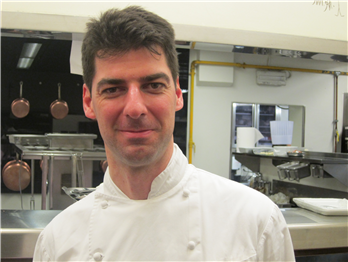Massimiliano Alajmo
Interviewed June 2012
Massimiliano Alajmo is the youngest chef ever to have been awarded three Michelin stars.
Q – How long have you been cooking professionally?
I have been cooking since the moment my mother gave me my first handful of flour. I grew up in the kitchen of Le Calandre, helping the chefs as best I could by rolling out the pasta dough or stirring a pot of risotto. Although I wasn’t given a monthly salary at the time, I was working in the kitchen everyday. My childhood food memories, the flavors and smells, are very much a part of my cooking today.
Q – Where did you train to cook?
Once I was old enough, I attended culinary school here in Padua and then set off to stage around Europe. First, I went to Alfredo Chiocchetti’s restaurant Scrigno del Duomo in the Trentino region of Italy. Then I decided to spend some time in France with Marc Veyrat at la Maison de Marc Veyrat and Michel Guerard at Les Prés d'Eugénie. I returned to Padua in 1993, full of excitement, and was hired by my mom to work at Le Calandre. I was 19 at the time.
Q – How would you describe your style of cooking?
My approach to cooking can be summed up with the word In.gredienti. The word comes from the Latin “ingredi” (to enter), from “in” (toward) and “gradi” (to advance) or “gradus” (step). There is no truth beyond that contained in the ingredients. My goal is to reach or penetrate the nucleus of the ingredient; and respond with respect and therefore lightness.
Q – Is there a secret for a successful restaurant?
If only I knew…
Q – Do you have a “signature dish” or favourite dish you enjoy cooking?
I have a number of so-called “signature dishes” that are always available at Le Calandre as part of the Grandi Classici tasting menu. At the moment, the menu begins with seared langoustines with fresh fava bean cheese, radicchio and apple; followed by a cuttlefish cappuccino; crispy buffalo’s milk ricotta and mozzarella cannelloni with tomato sauce; saffron risotto with liquorice powder; hand-chopped Piemontese beef with black truffle; and Cremossisimo, a dessert made of hazelnut praline, chocolate gelato, coffee granite and coffee mascarpone cream. This tasting menu is a belly dive into the classic that we have had on the a la carte menu over the past ten years.
Q – Do you have a favourite ingredient?
Yes, water. Recently, I have been researching the properties of water, both technically and conceptually. Water interests me because it can’t be confined. I am interested in transferring the concept of fluidity or liquidity to food. Which doesn’t mean eating liquid foods. Water carries with it all of the memories of the path it has taken, which when applied to cooking, means that every ingredient in a recipe must contribute the memory of the path it has taken to create harmony and fluidity.
Which restaurant do you most enjoy eating at on your night off?
At home with my family. I have three young daughters and I try to spend all of my down time with them and my wife, Maria Pia. If we decide to go out, I prefer to take them to informal restaurants, like nearby trattorie serving regional dishes. Often, however, I take them to check out what is going on at our other restaurants like La Montecchia in Selvezzano Dentro and Ristorante Quadri in Piazza San Marco, Venice.
What is your most interesting or fun experience from your time in restaurants?
Our clients. There have been so many interesting people to come through the door. I love talking with them after their meal about everything from medicine to art. I have learned a lot from my clients.
What would be your “last request” dish?
Bread and olive oil placed in the center of a round table, around which would be seated my family and closest friends. We would all share this simple, communal meal.
Is there another chef that you most admire?
My mother
Any advice you would give to someone wanting to become a chef?
To not read this interview! Just kidding. I would encourage them to develop as many interests as possible and to see the world, carefully observing their surroundings.
Any final thoughts you’d like to add?
I have been researching ways to create dairy sensations without the presence of milk or dairy. Starting from what may be considered a trivial consideration, we found that milk is the first ingredient that unites us as humans: the mother's milk that nourishes babies creates a gustatory and tactile complicity can gives us emotions and valid information for life. Based on this observation, we believe that the lactic-tactile (or dairy-like) sensations created by certain foods or dishes give us the reassurance and protection to every man intimately "re-searches." Otherwise, how could we explain the success of a dessert such as tiramisu or a simple caprese or a cappuccino? Don’t they all contain a strong dairy component? In fact. they are all dishes that combine reassuring contrasts that make them so "universal."
Current Restaurant
Le Calandre


